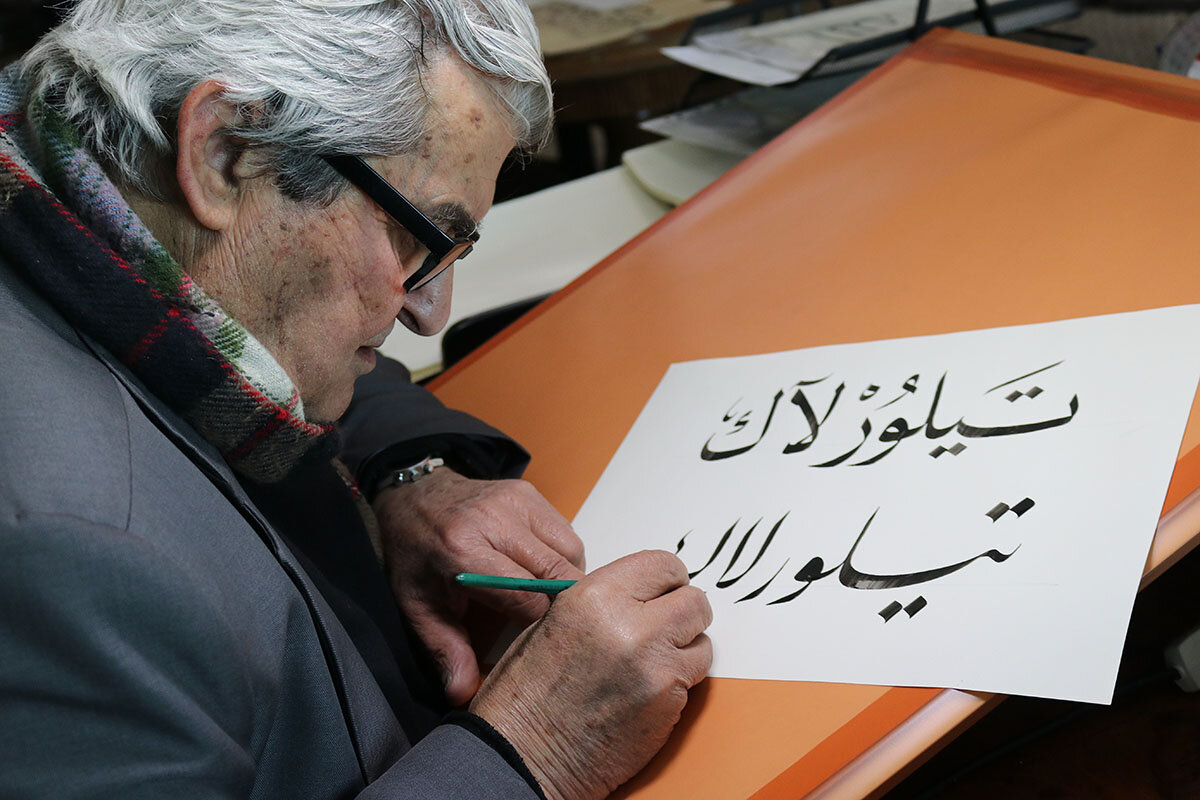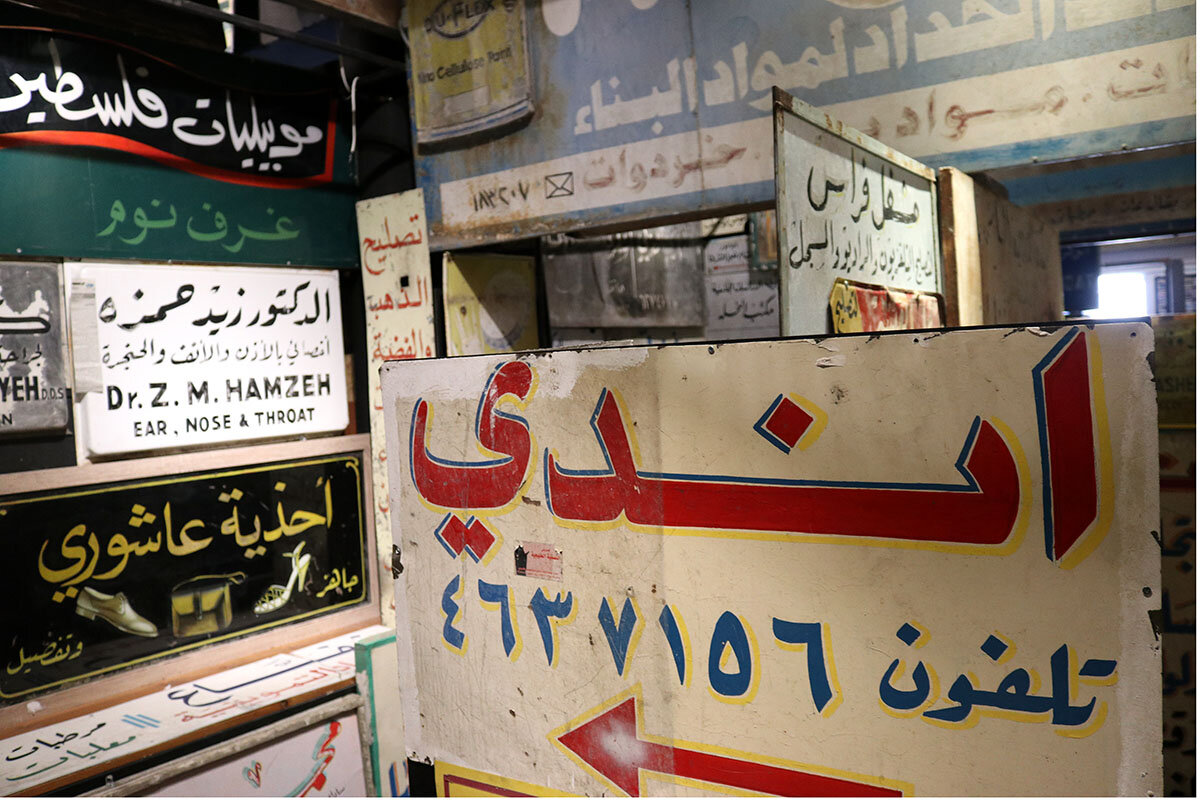Storefront history: Amman museum celebrates lost art of signage
Loading...
| AMMAN, Jordan
From the flip of the calligrapher’s brushstroke to the choice of Arabic script applied to sheets of metal and glass, the works are more than advertisements; they are signs of the times.
The Old Signs of Amman Museum that showcases these works tells hundreds of stories about the Jordanian capital and its shops, residents, and society as far back as the 1940s.
But perhaps the hand-painted signs’ most captivating story is that of the skill of the khattat, or professional calligrapher, who painted them.
Why We Wrote This
When computer designs replace handmade art, what is lost? In Jordan, a museum of old-time signs celebrates the artistry in which “each brushstroke is a line from our past to the present.”
Once upon a time, Jordanians were completely reliant on calligraphers.
Opening a grocery store? Decaling a truck? Wedding invitations? A royal letter? From the farmer to the king, Jordanians turned to a khattat.
The calligraphers drew from an armory of Arabic scripts, each taking years to master, such as the bold and simple Thuluth, the dainty and curvy Farsi, the blocky and thick Kufi scripts.
They would spend hours choosing the best font to fit the words and subject matter.
“You have to write in a way that is beautiful, readable, and suitable for the word and how the letters look together on a sign,” says Riad Tabbal, one of the last remaining khattats, who painted Amman’s cityscape with colorful Arabic calligraphy that Jordanians once relied on as landmarks.
Windows to the past
The unusual, free Old Signs of Amman Museum is the brainchild of Ghazi Khattab, a graphic designer whose love of Arabic calligraphy began when he was a child walking in downtown Amman in the 1970s.
He would ogle the colorful hodgepodge of signs that then dotted every building, the Arabic names twisting, curving, and ballooning in a mix between a sultan’s palace fresco and pop art.
The signs later inspired Mr. Khattab to study graphic art in Germany, open a modern sign press in Amman, and collect the vintage signs he now displays.
While vintage signs in the West were often produced in runs of 300 or more, Amman signs were custom-designed and painted by hand; like ink-blotted snowflakes, no two signs were alike.
“Each sign is a one-of-a-kind; you can see where the brushstroke started and stopped, where the brush was active, where it slowed, and where the understudy stepped in to finish the job,” Mr. Khattab tells visitors one Tuesday morning as he traces his first vintage sign with Sarsour, family name of the owners of a famous Amman garment shop, written in futuristic, blocky red-and-black letters.
The signs are also historical records, freeze frames of a lost Jordan.
They feature words that have disappeared from the Jordanian lexicon, including: nouveaut to mean new clothes, mobiliat for furniture, and couponat, unique sets of cloth sold by textile stores to customers wanting a bespoke suit no one could copy.
Other signs read “doctor is present,” from a time when receptionists were scarce.
One bold grocery shop billed itself as “The King’s Store,” advertising its royal certification by King Abdullah I as “By appointment to His Hashemite Majesty THE KING.”
Others were painted by Palestinian calligraphers from Jerusalem, carried by store owners when they were pushed into Jordan following the 1948 and 1967 wars with Israel, and eventually hung on their new shops, and new beginnings, in Amman.
A lost art
Months shy of his 80th birthday, Mr. Tabbal boasts a career including writing Royal Court letters and designing the logo for Royal Jordanian, the kingdom’s flagship airlines, which still adorns aircraft today.
His process for producing signs takes 10 to 15 days, starting with a coat of primer on a metal sheet, then a second coat of synthetic paint before painting the text, drying it again, and encasing the sign in a protective sheet of glass.
The most important step for Mr. Tabbal and his fellow calligraphers? The design.
Doctors’ and lawyers’ offices were given a simple, no-nonsense black-on-white Naskh script; a mosque would get a delicate, curvy Farsi script. A cafe or carbonated beverage? Calligraphers would splurge with curves, loops, and bubble lettering with extra shading to give the Arabic words an added 3D pop.
The finishing touch was the signature, a specially designed logo to tell the world – and rival calligraphers – this was their work.
Jordan’s self-taught calligraphers engaged each other in contests to see “who could write the most beautifully,” Mr. Tabbal says, spending extra hours and days to make the most intricate, complex, detailed Arabic script to one-up rivals – at no extra charge to the customer.
But with the rise of digitally printed calligraphy in the late 1990s, khattats lost 80% of their work, unable to compete with the machines that produced in hours what took them 10 days by hand.
Lost business is one thing; lost art is another.
“There is no spirit or originality in the text; it has taken an art form and turned it into something utilitarian and disgusting,” Mr. Tabbal says as he holds up an envelope with printed calligraphy, frowning, “and quite frankly, it just doesn’t look good.”
A way to give back
In the 1990s, as Jordanians and businesses traded in the colorful handmade artworks for cheaper, faster electronically produced calligraphy – like those Mr. Khattab himself printed – the graphic designer stepped in to rescue the retired works.
“By introducing modern methods, I was benefiting business owners, because our work was fast, clean, and efficient, but I was hurting the art,” Mr. Khattab says sheepishly. “It feels like I was betraying the Arabic language. This is my way of giving back.”
Mr. Khattab offered to take the vintage artwork from companies and factories that were upgrading in exchange for new signs free of charge, and intervened at businesses that were shuttering to prevent the masterpieces from ending up on the garbage heap.
Today, he restores vintage signs that the Amman municipality painted over in a uniform beige in 2006, and carefully glues together shattered signs.
Since Mr. Khattab opened the free museum in downtown Amman in December 2019, it has seen 6,000 visitors a month, sparking surprisingly personal connections.
Jordanians have discovered the sign of the school their father taught at, or that hung above their grandparents’ clinic.
A pair of older visitors huddle by the now-defunct Haifa Hotel sign, reminiscing about their youth. Others read their deceased father’s name emblazoned in ink on glass and, for a moment, sees him in their mind’s eye.
“I originally established the museum to preserve these signs as examples of Arabic calligraphy, but it turns out these signs mean much more; they are people’s memories, economy, politics, personal histories, and connections to loved ones,” Mr. Khattab says.
Says Mr. Tabbal, the calligrapher: “Each brushstroke is a line from our past to the present.”








